Numerical Analysis of End-Gas Autoignition and Pressure Oscillation in a Downsized SI Engine Using Large Eddy Simulation
Abstract
1. Introduction
2. Experimental Setting
2.1. Experimental Apparatus
2.2. Experimental Procedure
3. Numerical Settings
3.1. Turbulent Combustion Model
3.2. Numerical Models
3.3. Model Validations
3.4. General Combustion Phenomena Using LES
4. Results and Discussion
4.1. Knock Combustion Mechanism
4.1.1. Combustion Progress in ST-18
4.1.2. Combustion Progress at ST-22
4.2. Super-Knock Combustion Mechanism
5. Conclusions
- (1)
- Along with the advance of spark timing, the pressure oscillation starts earlier with higher amplitude, and a transition from knock to super-knock appears. The super-knock is observed in ST-26 and ST-28, in which the peak pressure exceeds 30 MPa. Though the intensity of knock increases, the mass fraction of unburned mixture when AI occurs under different spark timings is similar. However, as the spark timing advances, the flame propagates faster. As a result, the combustion and onset of autoignition is more likely to occur at TDC, which brings end gas a higher temperature and pressure. It is reasonable to conclude that knock intensity is not only proportional to the mass fraction of mixtures burned by AI but the thermodynamics of it instead.
- (2)
- In the conventional knock, the unburned mixture is preheated and compressed by the burned region as main flame propagates. Auto-ignition occurs at hot-spots near the cylinder wall, generating pressure waves. The thermodynamics state of remained unburned mixture is further increased under the coupling effects of the deflagration and the main flame until it is high enough to emerge new hot-spot that triggers second auto-ignition, generating stronger pressure waves as a result of higher HRR.
- (3)
- For further advancing ST that corresponding to the pre-ignition in engines such as ST-26, ST-28, an intense knock called super-knock occurs. As the pressure wave effects induced by the autoignition in the end gas on the local thermodynamics, the ignition delay time of unburned mixture ahead of auto-ignition flame shortens. Consequently, auto-ignition flame propagation velocity increases, which will generate new strong pressure wave. Overall, following the increase of flame propagation velocity, the transition of the autoignition modes is achieved from the subsonic combustion to supersonic combustion. This allows the coupling between pressure wave and AI flame that reinforces each other, leading to the DDT and super-knock occurrences.
Author Contributions
Funding
Conflicts of Interest
Abbreviations
| AMR | Adaptive Mesh Refinement | AI | Auto-ignition |
| aTDC | after Top Dead Center | BMF | Burned Mass Fraction |
| bTDC | before Top Dead Center | CFD | Computational Fluid Dynamics |
| CJ | Chapman-Jouguet | DDT | Deflagration to Detonation Transition |
| DNS | Direct Numerical Simulation | ECFM-LES | Extended Coherent Flame Model for LES |
| GDI | Gasoline Direct Injection | HCCI | Homogeneous charge compression ignition |
| HRR | Heat Release Rate | LES | Large Eddy Simulation |
| MAPO | maximum amplitude of pressure oscillations | RANS | Reynolds averaged Navier–Stokes |
| PRF | Primary Reference Fuel | PID | Proportional-Integral-Derivative |
| ST | Spark Timing | SI | Spark Ignition |
| TKI | Tabulated Kinetics for Ignition | TDC | Top Dead Center |
References
- Rudloff, J.; Zaccardi, J.M.; Richard, S.; Anderlohr, J.M. Analysis of pre-ignition in highly charged SI engines: Emphasis on the auto-ignition mode. Proc. Combust. Inst. 2013, 34, 2959–2967. [Google Scholar] [CrossRef]
- Sharma, N.; Patel, C.; Tiwari, N.; Agarwal, A.K. Experimental investigations of noise and vibration characteristics of gasoline-methanol blend fuelled gasoline direct injection engine and their relationship with combustion characteristics. Appl. Ther. Eng. 2019, 158, 113754. [Google Scholar] [CrossRef]
- Wei, H.; Yu, J.; Zhou, L. Improvement of engine performance with high compression ratio based on knock suppression using Miller cycle with boost pressure and split injection. Front. Energy 2019. [Google Scholar] [CrossRef]
- Wei, H.; Gao, D.; Zhou, L.; Feng, D.; Chen, R. Different combustion modes caused by flame-shock interactions in a confined chamber with a perforated plate. Combust. Flame 2017, 178, 277–285. [Google Scholar] [CrossRef]
- Wang, Z.; Liu, H.; Song, T.; Qi, Y.; He, X.; Shuai, S.; Wang, J. Relationship between super-knock and pre-ignition. Int. J. Engine Res. 2015, 16, 166–180. [Google Scholar] [CrossRef]
- Wang, Z.; Liu, H.; Reitz, R.D. Knocking combustion in spark-ignition engines. Prog. Energy Combust. Sci. 2017, 61, 78–112. [Google Scholar] [CrossRef]
- Xu, H.; Gao, J.; Yao, A.; Yao, C. The effect of the energy convergence and energy dissipation on the formation of severe knock. Appl. Energy 2018, 228, 1243–1254. [Google Scholar] [CrossRef]
- Vafamehr, H.; Cairns, A.; Sampson, O.; Koupaie, M.M. The competing chemical and physical effects of transient fuel enrichment on heavy knock in an optical spark ignition engine. Appl. Energy 2016, 179, 687–697. [Google Scholar] [CrossRef]
- Zaccardi, J.-M.; Escudié, D. Overview of the main mechanisms triggering low-speed pre-ignition in spark-ignition engines. Int. J. Engine Res. 2015, 16, 152–165. [Google Scholar] [CrossRef]
- Wei, H.; Zhao, J.; Zhou, L.; Xu, Z.; Gao, D. Pressure oscillation with destructive effect of flame propagation of a stoichiometric hydrogen-air mixture in a confined space. J. Hazard. Mater. 2018, 344, 1025–1033. [Google Scholar] [CrossRef]
- Konig, G.; Sheppard, C.G.W. End Gas Autoignition and Knock in a Spark Ignition Engine; SAE Transactions; SAE International: Tulsa, OK, USA, 1990; pp. 820–839. [Google Scholar]
- Bates, L.; Bradley, D. Deflagrative, auto-ignitive, and detonative propagation regimes in engines. Combust. Flame 2017, 175, 118–122. [Google Scholar] [CrossRef]
- Amann, M.; Mehta, D.; Alger, T. Engine Operating Condition and Gasoline Fuel Composition Effects on Low-Speed Pre-Ignition in High-Performance Spark Ignited Gasoline Engines. SAE Int. J. Engines 2011, 4, 274–285. [Google Scholar] [CrossRef]
- Steurs, K.; Blomberg, C.; Boulouchos, K. Formulation of a Knock Model for Ethanol and Iso-Octane under Specific Consideration of the Thermal Boundary Layer within the End-Gas. SAE Int. J. Engines 2014, 7, 1752–1772. [Google Scholar] [CrossRef]
- Wei, H.; Feng, D.; Pan, J.; Shao, A.; Pan, M. Knock characteristics of SI engine fueled with n-butanol in combination with different EGR rate. Energy 2017, 118, 190–196. [Google Scholar] [CrossRef]
- Wei, H.; Feng, D.; Pan, M.; Pan, J.; Rao, X.; Gao, D. Experimental investigation on the knocking combustion characteristics of n-butanol gasoline blends in a DISI engine. Appl. Energy 2016, 175, 346–355. [Google Scholar] [CrossRef]
- Zhou, L.; Kang, R.; Wei, H.; Feng, D.; Hua, J.; Pan, J.; Chen, R. Experimental analysis of super-knock occurrence based on a spark ignition engine with high compression ratio. Energy 2018, 165, 68–75. [Google Scholar] [CrossRef]
- Bares, P.; Selmanaj, D.; Guardiola, C.; Onder, C. A new knock event definition for knock detection and control optimization. Appl. Ther. Eng. 2018, 131, 80–88. [Google Scholar] [CrossRef]
- Shen, X.; Zhang, Y.; Shen, T. Cylinder pressure resonant frequency cyclic estimation-based knock intensity metric in combustion engines. Appl. Ther. Eng. 2019, 158, 113756. [Google Scholar] [CrossRef]
- Zhou, L.; Shao, A.; Hua, J.; Wei, H.; Feng, D. Effect of Retarded Injection Timing on Knock Resistance and Cycle to Cycle Variation in Gasoline Direct Injection Engine. J. Energy Resour. Technol. 2018, 140, 072202. [Google Scholar] [CrossRef]
- Zhou, L.; Gao, D.; Zhao, J.; Wei, H.; Zhang, X.; Xu, Z.; Chen, R. Turbulent flame propagation with pressure oscillation in the end gas region of confined combustion chamber equipped with different perforated plates. Combust. Flame 2018, 191, 453–467. [Google Scholar] [CrossRef]
- Wei, H.; Zhang, X.; Zeng, H.; Deiterding, R.; Pan, J.; Zhou, L. Mechanism of end-gas autoignition induced by flame-pressure interactions in confined space. Phys Fluids 2019, 31, 076106. [Google Scholar]
- Wei, H.; Zhao, J.; Zhang, X.; Pan, J.; Hua, J.; Zhou, L. Turbulent flame–shock interaction inducing end-gas autoignition in a confined space. Combust. Flame 2019, 204, 137–141. [Google Scholar] [CrossRef]
- Merola, S.S.; Vaglieco, B.M. Knock investigation by flame and radical species detection in spark ignition engine for different fuels. Energy Convers. Manag. 2007, 48, 2897–2910. [Google Scholar] [CrossRef]
- Kawahara, N.; Tomita, E.; Sakata, Y. Auto-ignited kernels during knocking combustion in a spark-ignition engine. Proc. Combust. Inst. 2007, 31, 2999–3006. [Google Scholar] [CrossRef]
- Tanoue, K.; Jimoto, T.; Kimura, T.; Yamamoto, M.; Hashimoto, J. Effect of initial temperature and fuel properties on knock characteristics in a rapid compression and expansion machine. Proc. Combust. Inst. 2017, 36, 3523–3531. [Google Scholar] [CrossRef]
- Westbrook, C.K.; Mehl, M.; Pitz, W.J.; Sjöberg, M. Chemical kinetics of octane sensitivity in a spark-ignition engine. Combust. Flame 2017, 175, 2–15. [Google Scholar] [CrossRef]
- Yang, Y.; Dec, J.E.; Sjöberg, M.; Ji, C. Understanding fuel anti-knock performances in modern SI engines using fundamental HCCI experiments. Combust. Flame 2015, 162, 4008–4015. [Google Scholar] [CrossRef]
- Wang, Z.; Qi, Y.; He, X.; Wang, J.; Shuai, S.; Law, C.K. Analysis of pre-ignition to super-knock: Hotspot-induced deflagration to detonation. Fuel 2015, 144, 222–227. [Google Scholar] [CrossRef]
- Wang, Z.; Qi, Y.; Liu, H.; Zhang, P.; He, X.; Wang, J. Shock wave reflection induced detonation (SWRID) under high pressure and temperature condition in closed cylinder. Shock Waves 2016, 26, 687–691. [Google Scholar] [CrossRef]
- D’Adamo, A.; Breda, S.; Fontanesi, S.; Irimescu, A.; Merola, S.S.; Tornatore, C. A RANS knock model to predict the statistical occurrence of engine knock. Appl. Energy 2017, 191, 251–263. [Google Scholar] [CrossRef]
- Robert, A.; Richard, S.; Colin, O.; Poinsot, T. LES study of deflagration to detonation mechanisms in a downsized spark ignition engine. Combust. Flame 2015, 162, 2788–2807. [Google Scholar] [CrossRef]
- Yu, H.; Chen, Z. End-gas autoignition and detonation development in a closed chamber. Combust. Flame 2015, 162, 4102–4111. [Google Scholar] [CrossRef]
- Wang, Z.; Wang, Y.; Reitz, R.D. Pressure Oscillation and Chemical Kinetics Coupling during Knock Processes in Gasoline Engine Combustion. Energy Fuel 2012, 26, 7107–7119. [Google Scholar] [CrossRef]
- Zhou, L.; Dong, K.; Hua, J.; Wei, H.; Chen, R.; Han, Y. Effects of applying EGR with split injection strategy on combustion performance and knock resistance in a spark assisted compression ignition (SACI) engine. Appl. Ther. Eng. 2018, 145, 98–109. [Google Scholar] [CrossRef]
- Livengood, J.C.; Wu, P.C. Correlation of autoignition phenomena in internal combustion engines and rapid compression machines. Symp. Int. Combust. 1955, 5, 347–356. [Google Scholar] [CrossRef]
- Heywood, J.B. Internal Combustion Engine Fundamentals; McGraw-Hill Education: New York, NY, USA, 1988. [Google Scholar]
- Lafossas, F.-A.; Castagne, M.; Dumas, J.-P.; Henriot, S. Development and Validation of a Knock Model in Spark Ignition Engines Using a CFD Code; Report No. 0148-7191; SAE Technical Paper; SAE International: San Diego, CA, USA, 2002. [Google Scholar]
- Shao, J.; Rutland, C. Modeling Investigation of Auto-Ignition and Engine Knock by HO2; Report No. 0148-7191; SAE Technical Paper; SAE International: Detroit, MI, USA, 2014. [Google Scholar]
- Réveillé, B.; Duparchy, A. 3D CFD analysis of an abnormally rapid Combustion phenomenon in downsized gasoline engines. Oil Gas Sci. Technol. Rev. de l’IFP 2009, 64, 431–444. [Google Scholar]
- Robert, A.; Richard, S.; Colin, O.; Martinez, L.; de Francqueville, L. LES prediction and analysis of knocking combustion in a spark ignition engine. Proc. Combust. Inst. 2015, 35, 2941–2948. [Google Scholar] [CrossRef]
- Pal, P.; Wu, Y.; Lu, T.; Som, S.; See, Y.C.; le Moine, A. Multidimensional Numerical Simulations of Knocking Combustion in a Cooperative Fuel Research Engine. J. Energy Resour. Technol. 2018, 140, 102205. [Google Scholar] [CrossRef]
- Lecocq, G.; Richard, S.; Michel, J.-B.; Vervisch, L. A new LES model coupling flame surface density and tabulated kinetics approaches to investigate knock and pre-ignition in piston engines. Proc. Combust. Inst. 2011, 33, 3105–3114. [Google Scholar] [CrossRef]
- Zhou, L.; Hua, J.; Wei, H.; Dong, K.; Feng, D.; Shu, G. Knock characteristics and combustion regime diagrams of multiple combustion modes based on experimental investigations. Appl. Energy 2018, 229, 31–41. [Google Scholar] [CrossRef]
- Tan, Z.; Reitz, R.D. Development of a Universal Turbulent Combustion Model for Premixed and Direct Injection Spark/Compression Ignition Engines; SAE International: Detroit, MI, USA, 2004. [Google Scholar]
- Liang, L.; Reitz, R.D.; Iyer, C.O.; Yi, J. Modeling Knock in Spark-Ignition Engines Using a G-equation Combustion Model Incorporating Detailed Chemical Kinetics; SAE International: Detroit, MI, USA, 2007. [Google Scholar]
- Liu, Y.-D.; Jia, M.; Xie, M.-Z.; Pang, B. Enhancement on a Skeletal Kinetic Model for Primary Reference Fuel Oxidation by Using a Semidecoupling Methodology. Energy Fuels 2012, 26, 7069–7083. [Google Scholar] [CrossRef]
- Senecal, P.K.; Pomraning, E.; Richards, K.J.; Briggs, T.E.; Choi, C.Y.; McDavid, R.M.; Patterson, M.A. Multi-Dimensional Modeling of Direct-Injection Diesel Spray Liquid Length and Flame Lift-off Length Using CFD and Parallel Detailed Chemistry; SAE International: Detroit, MI, USA, 2003. [Google Scholar]
- Ewald, J.; Peters, N. A Level Set Based Flamelet Model for the Prediction of Combustion in Spark igNition Engines. In Proceedings of the 15th International Multidimensional Engineering Models User Group, Detroit, MI, USA, 11 April 2005; pp. 1–6. [Google Scholar]
- Metghalchi, M.; Keck, J.C. Burning velocities of mixtures of air with methanol, isooctane, and indolene at high pressure and temperature. Combust. Flame 1982, 48, 191–210. [Google Scholar] [CrossRef]
- Gülder, Ö.L. Correlations of Laminar Combustion Data for Alternative SI Engine Fuels; Report No. 0148-7191; SAE Technical Paper; SAE Internaional: San Diego, CA, USA, 1984. [Google Scholar]
- Yoshizawa, A.; Horiuti, K. A statistically-derived subgrid-scale kinetic energy model for the large-eddy simulation of turbulent flows. J. Phys. Soc. Jpn. 1985, 54, 2834–2839. [Google Scholar] [CrossRef]
- Menon, S.; Calhoon, W.H. Subgrid mixing and molecular transport modeling in a reacting shear layer. Symp. Int. Combust. 1996, 26, 59–66. [Google Scholar] [CrossRef]
- Reitz, R. Modeling atomization processes in high-pressure vaporizing sprays. At. Spray Technol. 1987, 3, 309–337. [Google Scholar]
- Amsden, A.A.; Findley, M. KIVA-3V: A Block-Structured KIVA Program for Engines with Vertical or Canted Valves; Lawrence Livermore National Lab(LLNL): Livermore, CA, USA, 1997. [Google Scholar]
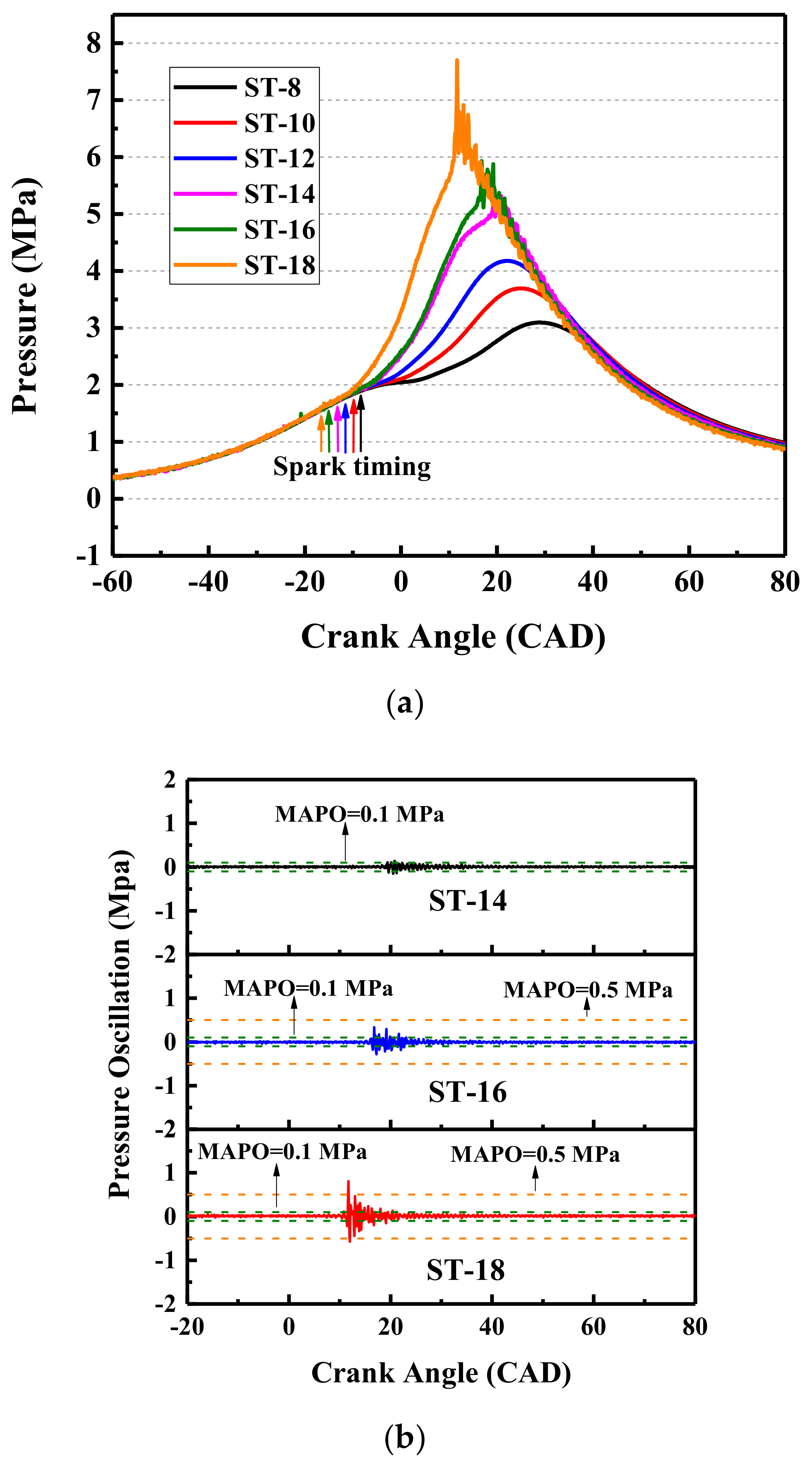
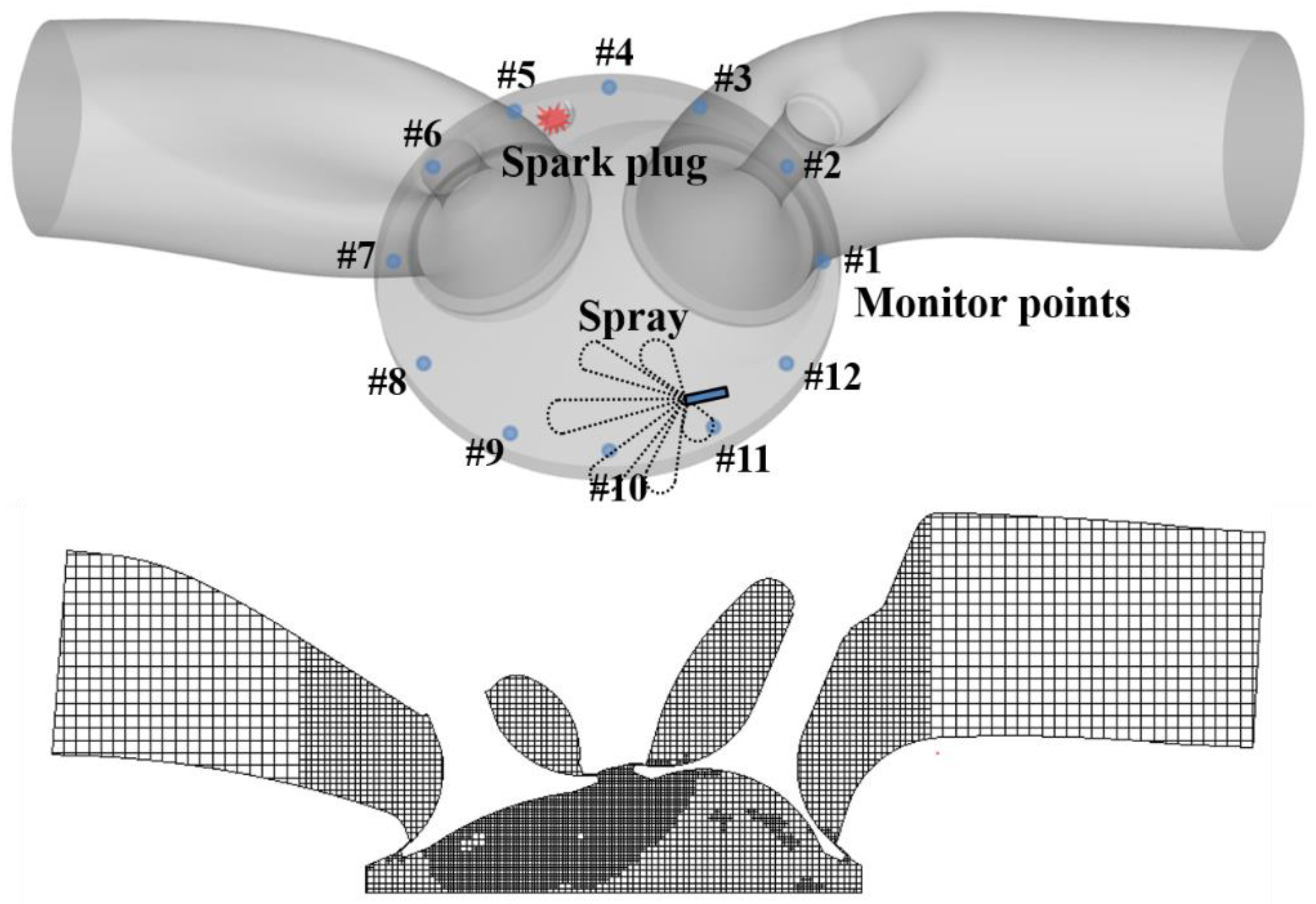
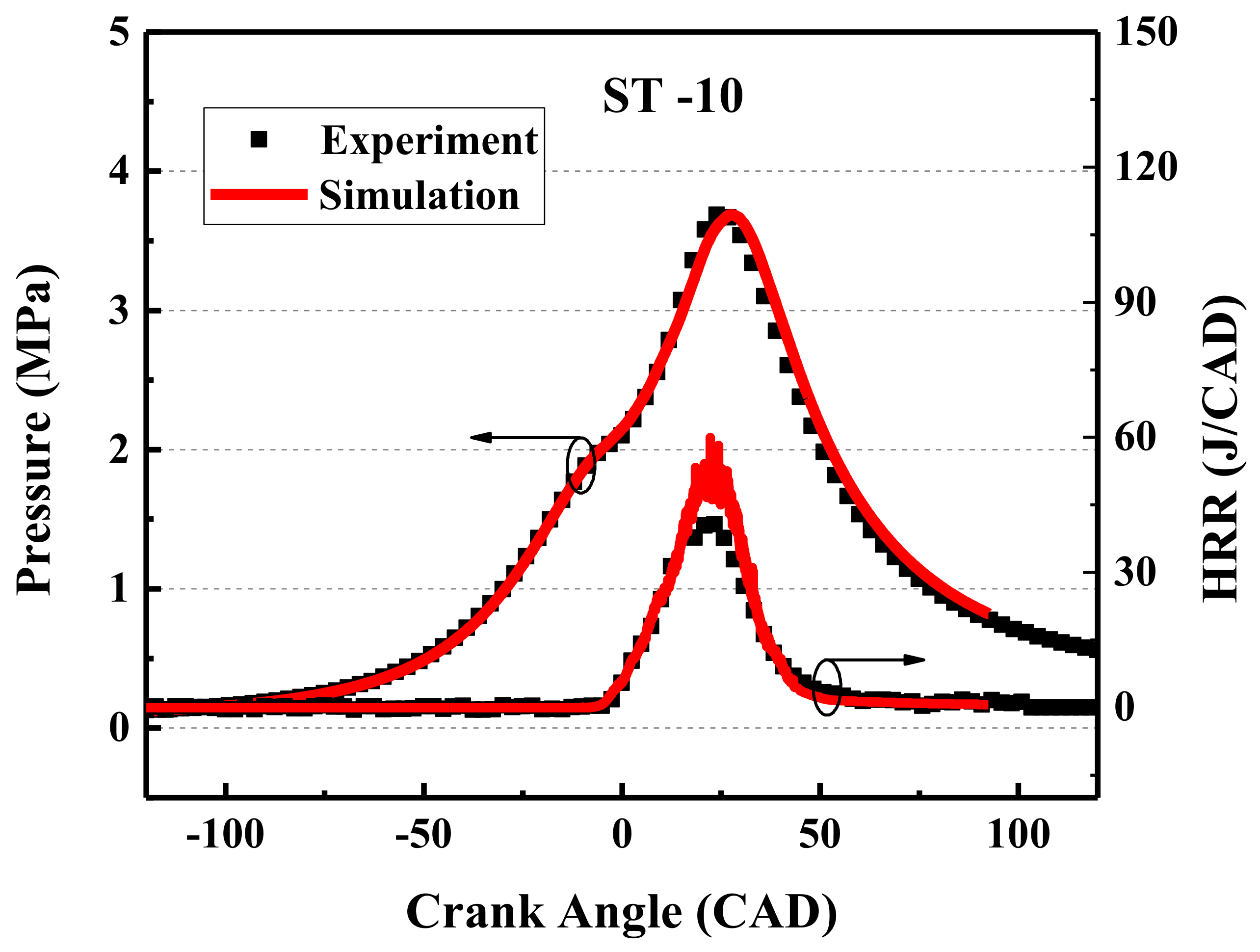
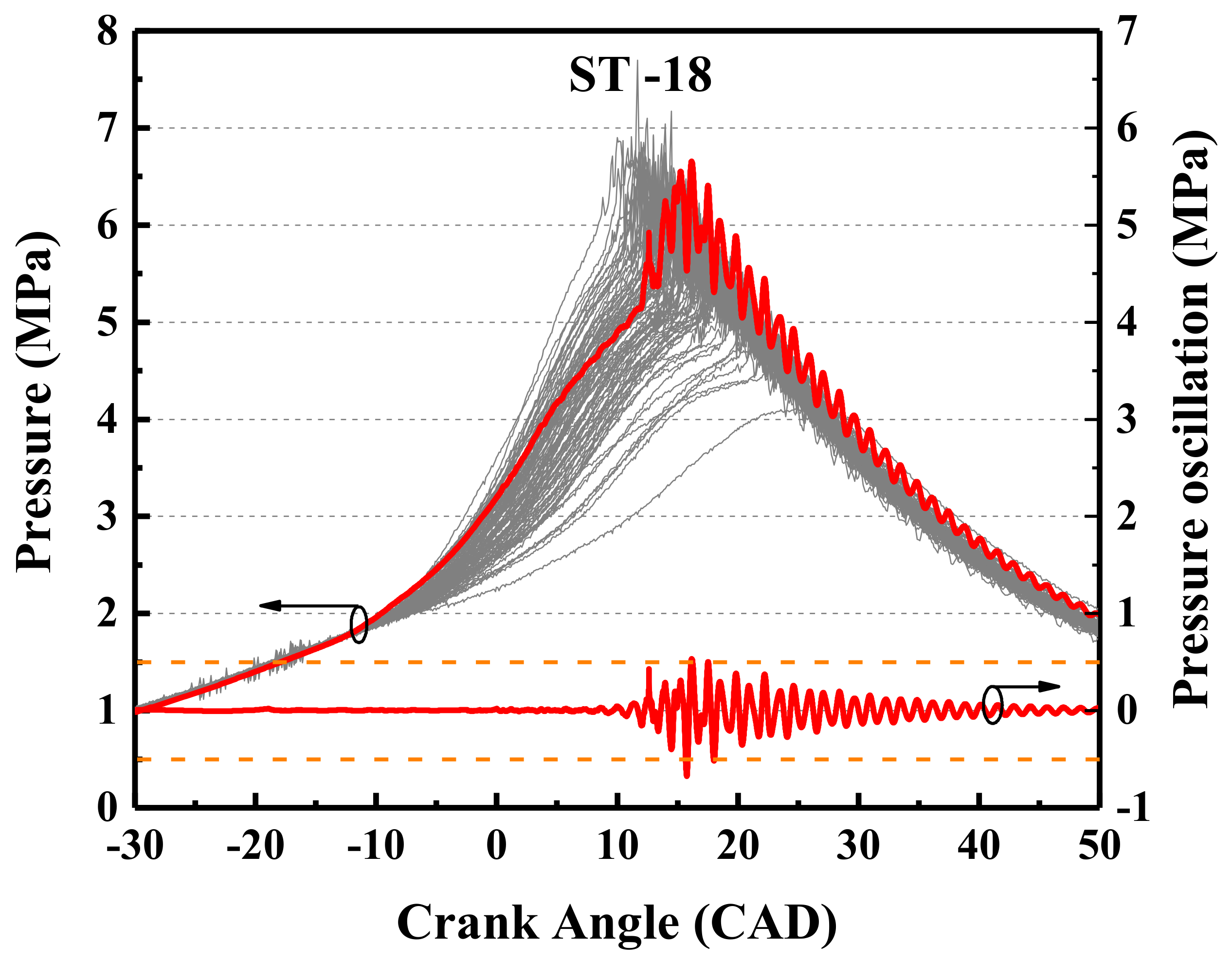
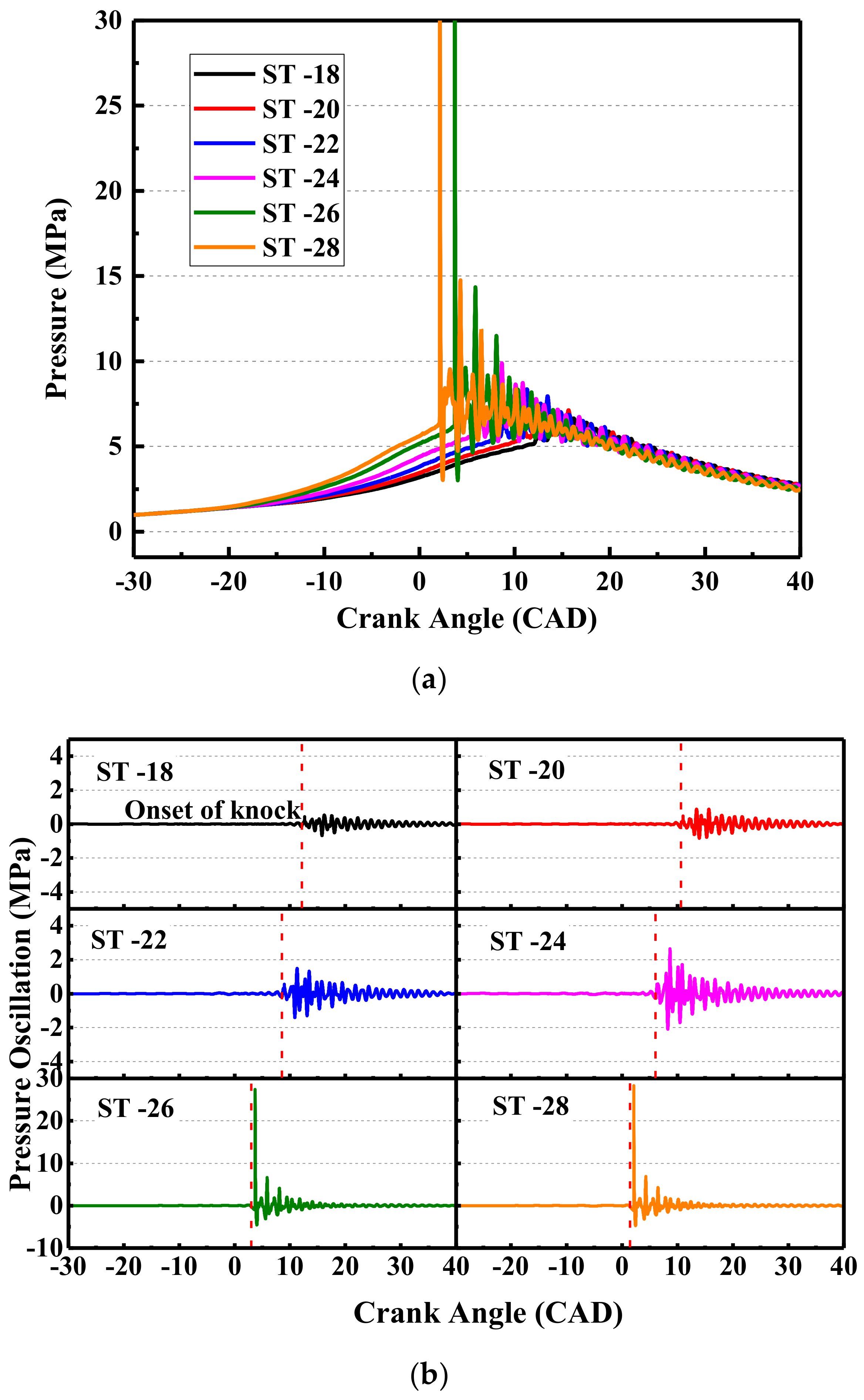
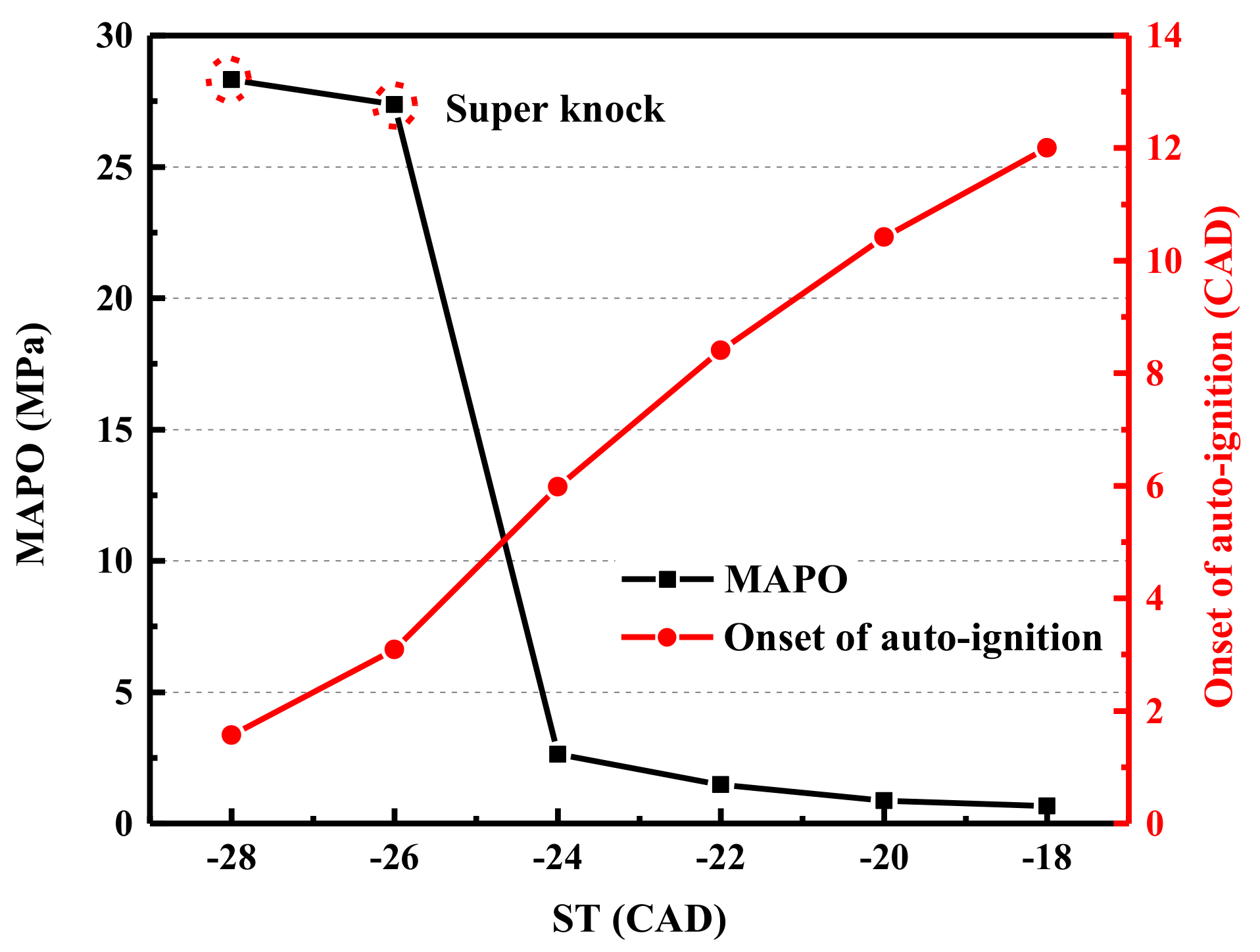
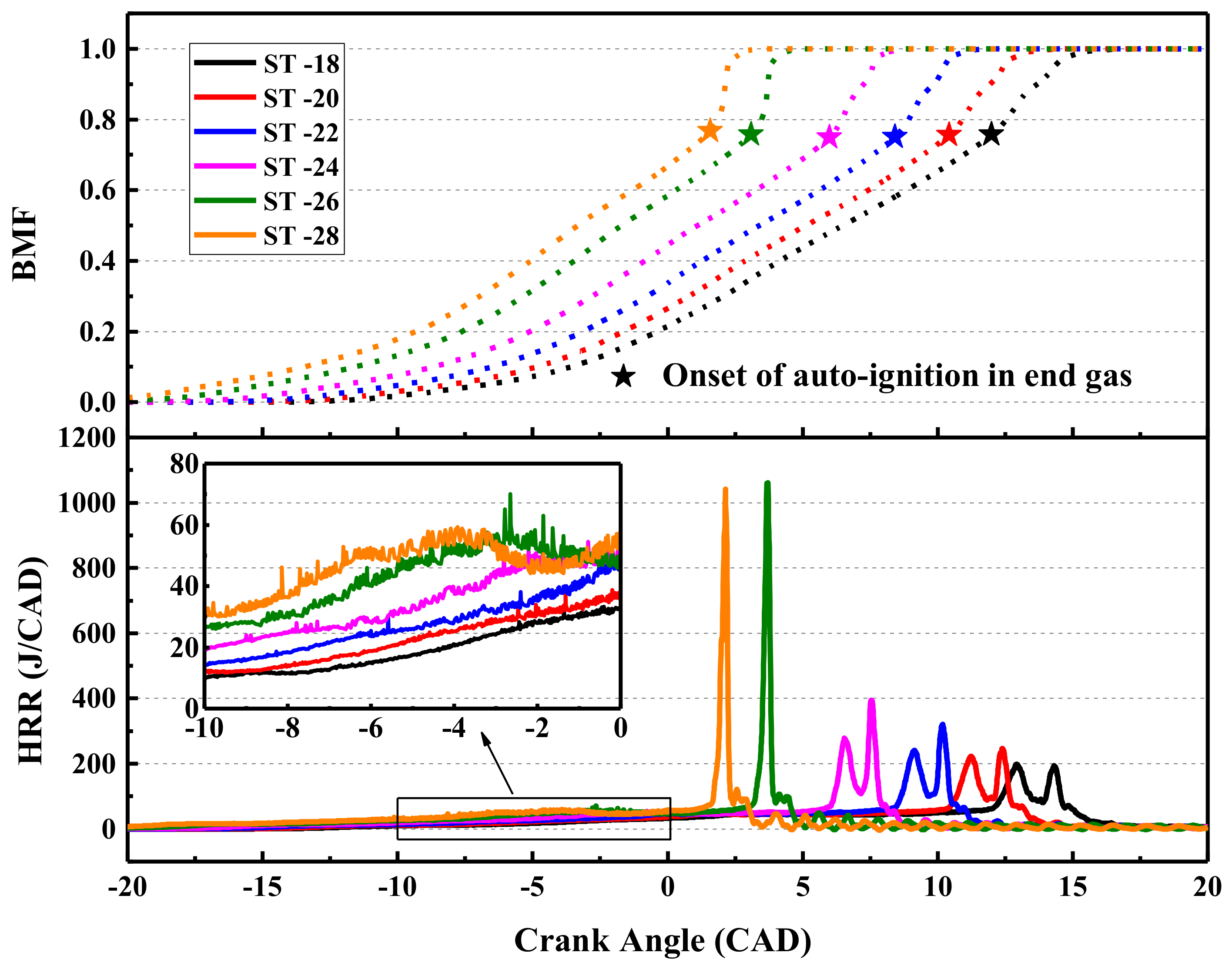


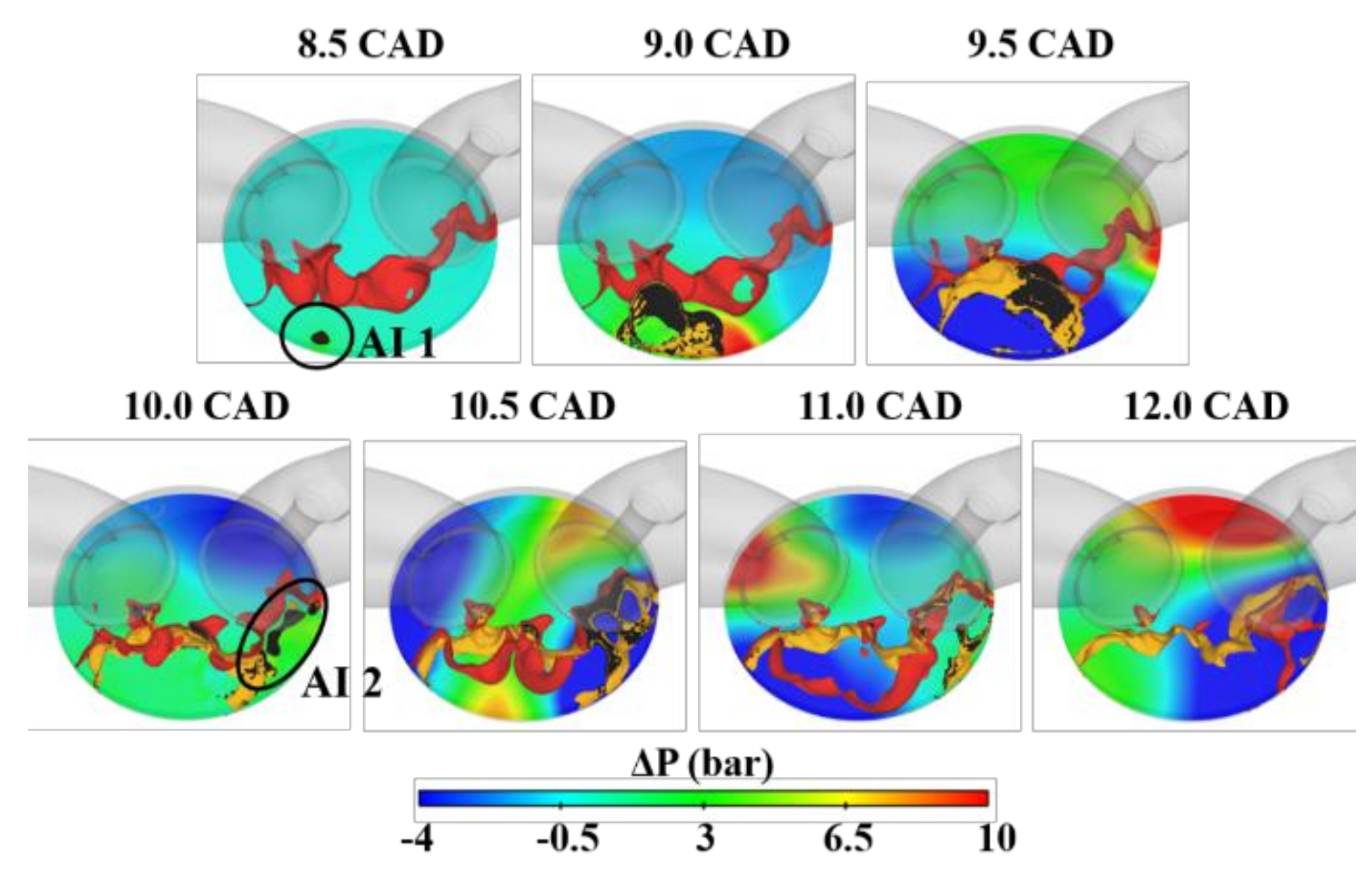



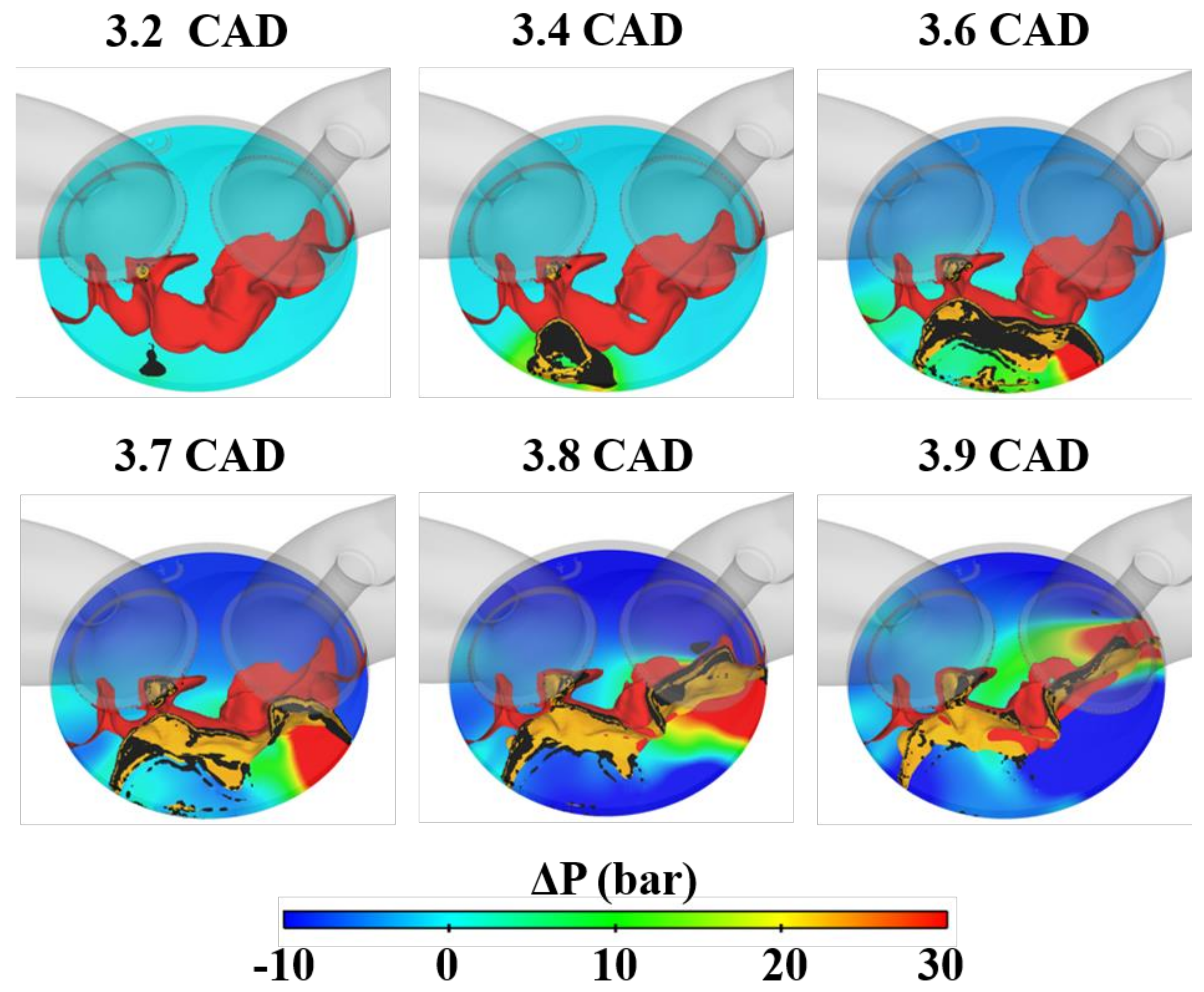
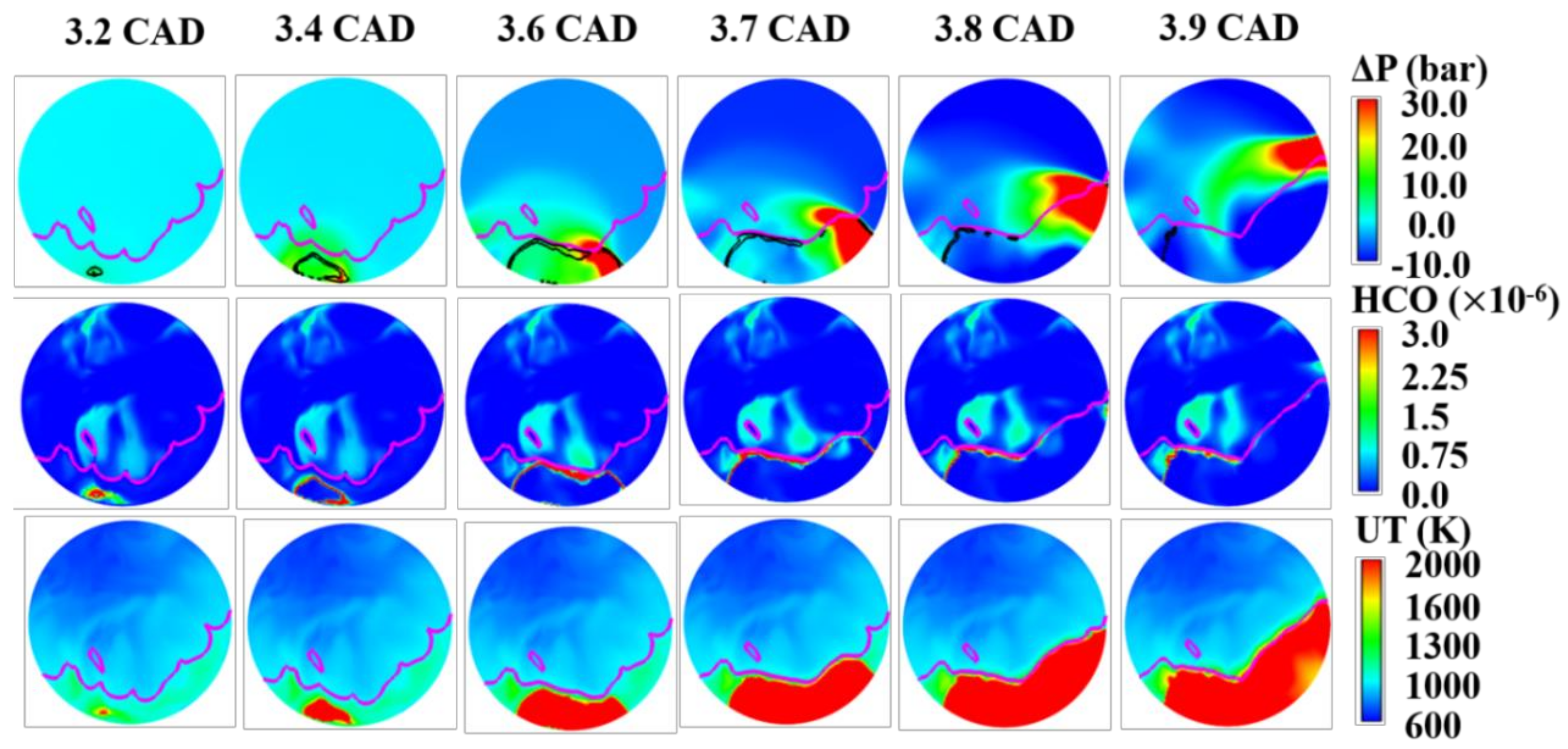
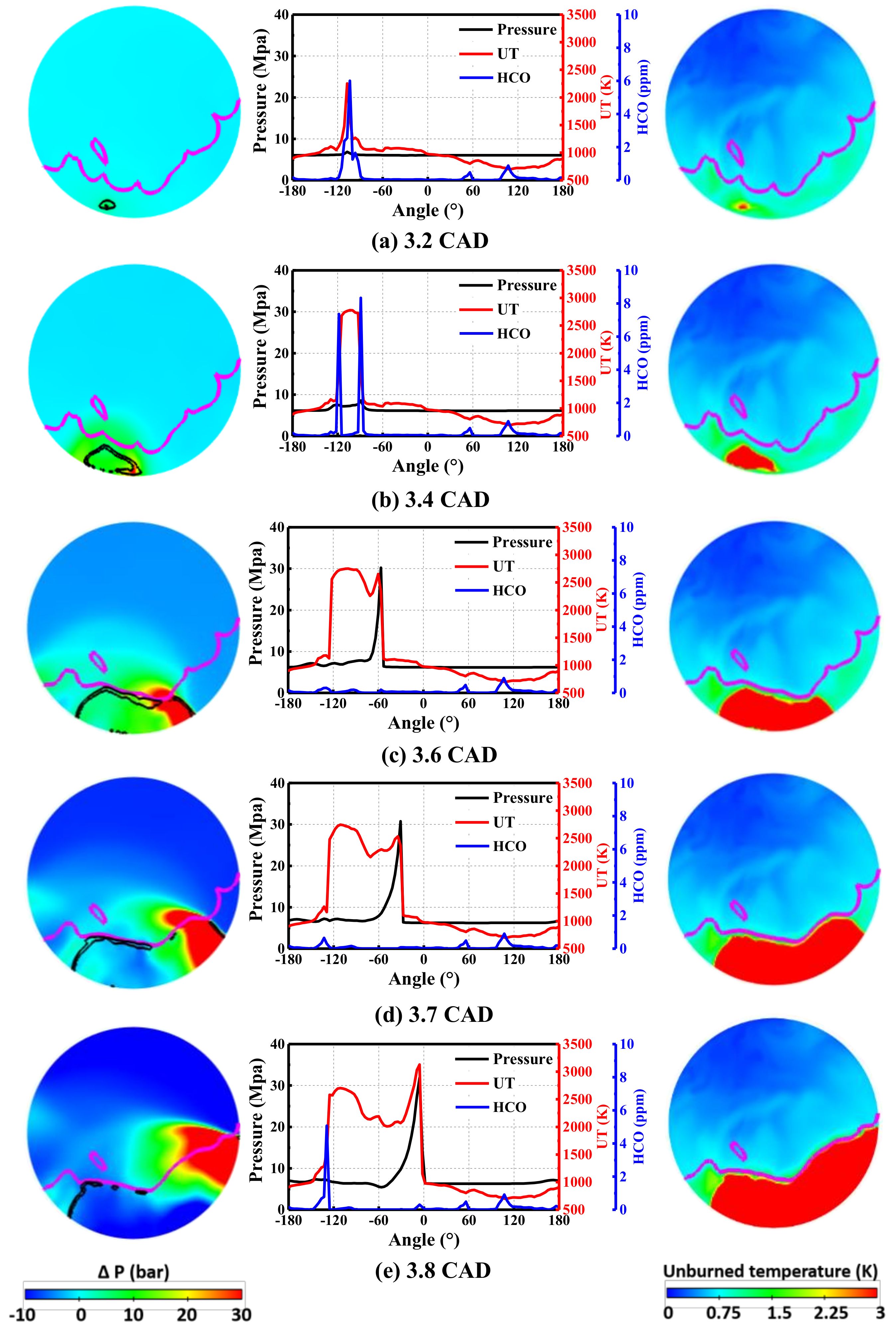
| Parameter | Value |
|---|---|
| Compression ratio | 10:1 |
| Rotational speed | 1600 rpm |
| Throttle angle | Fully open |
| Equivalence ratio | 1.0 |
| Intake pressure | 1 atm |
| Intake temperature | 25 °C |
| Injection pressure | 125 bar |
| Injection timing | 240 CAD bTDC |
| Fuel | RON92 (PRF92) |
| Fuel consumption | 1.64 kg/h |
| Spark timing | −8, −10, −12, −14, −16, −18 CAD |
| IVO/IVC | 350/590 CAD |
| EVO/EVC | 160/380 CAD |
© 2019 by the authors. Licensee MDPI, Basel, Switzerland. This article is an open access article distributed under the terms and conditions of the Creative Commons Attribution (CC BY) license (http://creativecommons.org/licenses/by/4.0/).
Share and Cite
Zhong, L.; Liu, C. Numerical Analysis of End-Gas Autoignition and Pressure Oscillation in a Downsized SI Engine Using Large Eddy Simulation. Energies 2019, 12, 3909. https://doi.org/10.3390/en12203909
Zhong L, Liu C. Numerical Analysis of End-Gas Autoignition and Pressure Oscillation in a Downsized SI Engine Using Large Eddy Simulation. Energies. 2019; 12(20):3909. https://doi.org/10.3390/en12203909
Chicago/Turabian StyleZhong, Lijia, and Changwen Liu. 2019. "Numerical Analysis of End-Gas Autoignition and Pressure Oscillation in a Downsized SI Engine Using Large Eddy Simulation" Energies 12, no. 20: 3909. https://doi.org/10.3390/en12203909
APA StyleZhong, L., & Liu, C. (2019). Numerical Analysis of End-Gas Autoignition and Pressure Oscillation in a Downsized SI Engine Using Large Eddy Simulation. Energies, 12(20), 3909. https://doi.org/10.3390/en12203909




